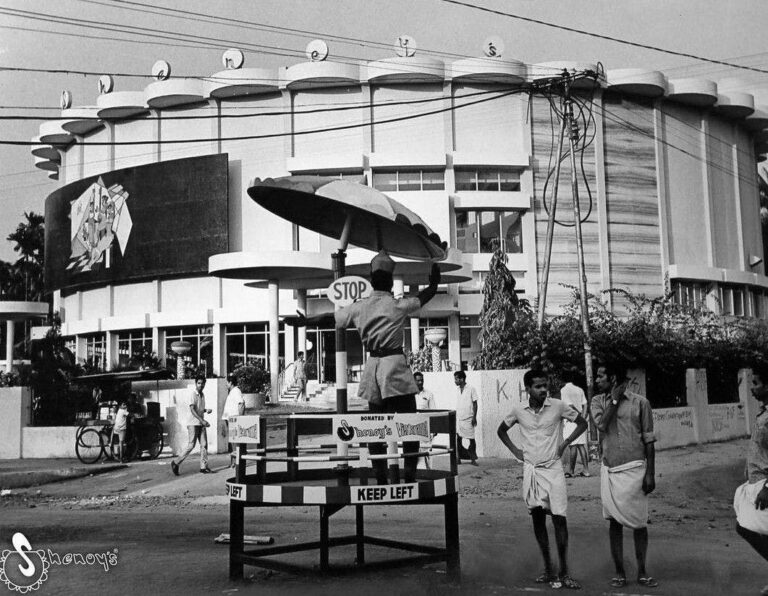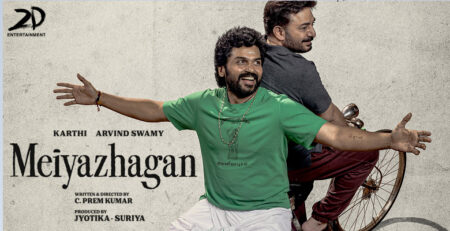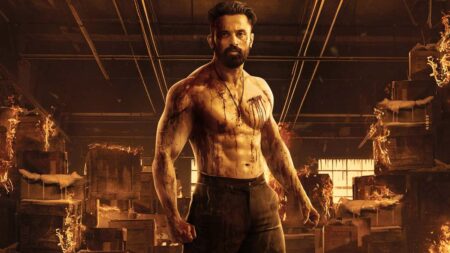Hollywood, Bollywood and Malayalam movies opened up a new world to a little boy who shifted to Trivandrum in the early 1970s.
In 1972, my father was posted to Trivandrum, his last posting before his retirement due in 1974. It was like being transported to a wonderland. After dusty, smelly, hot cities and towns in North India, I was suddenly in a green paradise with broad tree lined avenues, lovely old red stone buildings, quaint doddering double decker buses and a landscape almost totally bereft of those ugly multi story buildings. Trivandrum in the early seventies was probably the most beautiful town in the country and certainly the cleanest. Most importantly, it had lots of libraries. It was like landing up in fabled Xanadu or Shangri La. We stayed briefly in the Army Mess Bungalow on the tip of Cotton Hill before moving to a four storied house in Belhaven (which my mother hated) and thence to Sasthamangalam. The final five years of our stay in Trivandrum was in P.T.P. Nagar.This paradise had only one drawback. It didn’t have an open-air film theatre for Army families like in Mathura. If you wanted to watch a movie you had to go to one of the theatres in the city. There was another drawback. ‘She Who Must Be Obeyed’ (I often think Rider Haggard must have got the idea for his iconic character from my mother) decreed that we could only see two films a year at the theatre.
Talk about being in a quandary. After a staple diet of two films a week in Mathura it was down to two films a year. That too, after reaching a consensus with the little ogre as to which film we should go for. My sister had a simple rule in life. She liked everything I didn’t and disliked everything I liked. Reaching a consensus with her involved levels of diplomacy even Henry Kissinger couldn’t aspire to. A certain amount of bribery was also involved. The first film we watched after arriving in Trivandrum, after getting ‘You Know Who’ to agree with great difficulty, was ‘How The West Was Won’ (1962). The film had taken a decade to reach our shores. This was a magnificent western epic and I was a sucker for westerns. Moreover, it was in Cinerama and could only be screened on a 70mm wide screen, as opposed to the 35mm screens. Trivandrum boasted of just one such theatre in those days, called New Theatre.
My dad took us to New Theatre on his trusty Vespa scooter, a staid, plodding vehicle which believed in a quiet life and turned its nose up at younger faster moving upstarts. It flatly refused to go at over thirty-five miles per hour. On finally reaching the theatre, we were awed by the magnificence of the building, a far cry from the good old open-air theatre in Mathura. The screen was covered by a curtain which had tiny lights along the bottom. The curtain was raised to the strains of a jaunty tune which I later came to know was called ‘Popcorn’.Listening to the tune even now recalls the excitement and anticipation we felt as the curtain rose. The film was epic, almost every major Hollywood star was in it. John Wayne, James Stewart, Gregory Peck, Debbie Reynolds, Carroll Baker, Richard Widmark, Henry Fonda, George Peppard, Eli Wallach the list of stars went on and on. The episodic history of the role played by one family in the expansion of the old West, it told the story of the Mountain Men, the Civil War, the Ranchers, the Railroad, the Cattlemen, the Outlaws and the Lawmen. Directed by three great directors Henry Hathaway, John Ford and George Marshall it was a magnificent spectacle. I was in heaven, all the various elements of different western movies in one movie. I especially loved James Stewart’s intrepid mountain man and George Peppard as the lawman fighting off a train robbery.
Becoming a Movie Buff
Having tasted blood, I was soon hankering to see my next movie. Having become addicted to the medium in Mathura I was now like an addict forced to go ‘cold turkey. Unfortunately, there was no remedy. I had to wait several months before I saw an advertisement in the newspapers for a movie called ‘The Anderson Tapes’ ( 1971). The film was based on a book by Lawrence Sanders which I read several years later. The movie starred Sean Connery, fresh from his exploits as ‘James Bond’ the man with the license to kill. I was yet to see any Bond movie but knew this was the actor who portrayed Bond. First, I had to convince the Terror who wanted to see a fairy tale movie. I managed to convince her that the movie was based on the fairy tales of Hans Christian Andersen. Off we went of Dad’s Vespa, this time to Sreekumar Theatre.The film was a very well-made heist movie but I had two grouses against it. One was that the hero, Connery was actually a criminal recently released from prison and planning his next caper, robbing an entire apartment complex. I preferred my heroes to be lawmen, detectives, secret agents or policemen. I had no sympathy for criminals, even if played by James Bond. I was left unshaken and certainly wasn’t stirred. After finally shedding my prejudice and getting into the movie it was an absolute letdown when the lead actor (I hesitate to call him a hero) is killed at the end. What a waste of time investing in a character only for him to conk off in the end. What with that and my sister constantly asking when we were going to see the princesses, witches, wizards and dragons, it was a real downer. I wanted to tell her that if she wanted to see a witch she only had to look into the mirror. Better sense prevailed however. One does not wish to be turned into a frog.
The next film I remember watching was another western ‘Valdez is Coming’ (1971) with Burt Lancaster. This was several months later and I remember the advertisement for the film in the local ‘Kerala Kaumudi’ newspaper. It showed the looming silhouette of a gunman with the sun blazing behind him. The blurb under the picture said ‘tell your friends and family that ‘Valdez is Coming’. I lost no time in telling my family and after much pleading, whining and cajoling off we went to Sreekumar theatre. The film is about a black man living in a shack with his pregnant Indian wife, who is falsely accused of murder by a rich rancher. The old, grizzled half breed sheriff tries to reason with the man but is tricked into killing him. After finding out that the man was in fact innocent, the old sheriff tries to get the rancher to pay compensation to the Indian wife but is laughed at and then brutally beaten, tied to a wooden cross and left in the desert. He drags himself back to his shack and pulls out his old trunk containing his old cavalry uniform, photos of his time in the army and his buffalo gun. By now I was getting impatient. Where was Burt Lancaster. I was expecting the hero to ride in any moment to help the old codger.
I impatiently nudged my father and asked him when the hero, Burt Lancaster, would appear. Imagine my surprise and horror when my father told me that the grizzled old coot was Burt Lancaster. Here I was dreaming about the stalwart, young hero who would ride in to save the day and all the time the hero was this ancient with one foot in the grave. I was devastated. Soon however my interest quickened. The old codger suddenly gathered together the remnants of his pride and went after the bad guys with a vengeance. He kidnaps the rich rancher’s mistress, starts picking off his riders one by one and really kicks up a storm like a geriatric Rambo on steroids. I was really rooting for him by the end and my father had to restrain me from standing up and cheering. It turned out to be a terrific film in the end though I still feel the hero should have been 30 years younger. It is now one of my favorite Lancaster westerns along with ‘ Lawman’ , ‘The Professionals’ and ‘Vera Cruz’. I later read the book the film was based on, a real cracker by Elmore Leonard who wrote some great westerns before moving to the more lucrative crime thriller field. More’s the pity.
The next movie I saw several months later was that cult classic that turned Bruce Lee into a worldwide star. ‘Enter The Dragon’ (1973) ran for months in Sreekumar Theatre and was a huge hit worldwide and especially in India. We finally managed to get tickets a couple of months into its run and boy did the movie kick ass. It resulted in popularizing kung fu movies in India and for almost 20 years afterward any movie that had actors screaming, making strange grunting noises and performing high kicks and low blows raked in the moolah. Jackie Chan, Jet Li, Jean Claude Van Damme, Chuck Norris and several others went on to become major action stars but none matched the charismatic Bruce Lee with his flashing eyes, cool moves and fabulous physique. The fact that he usually had very little dialogue and concentrated on what he was best at, probably helped. For months afterwards I’d startle my friends and family by suddenly making yowling noises, kicking in random directions and flailing my arms about. Beware, I know Chinese kung fu. You can call me Sensei.
Other movies I watched in the early seventies included the John Travolta superhits ‘Saturday Night fever’ (1977) and ‘Grease’ (1978). These led a period where I would insist on wearing 18-inch bell bottoms, suddenly strike a pose with one hand on my hip and the other pointing at the ceiling, and gyrating my hips while humming ‘Staying Alive’.I’m lucky I got away with a few nasty looks and choice insults. This was probably because very other teenager was doing the same. A time I am trying my best to forget.
Movies from the Homeland
During this period, I also watched a few Indian films. I saw ‘Sholay’ (1975), probably the biggest hit in Indian film history, at Shenoys Theatre in Ernakulam with my family and my aunt and cousins. I loved it as it was a ‘desi’ western with a few scenes lifted directly from Sergio Leone’s ‘Once Upon a Time In The West’. The performances by the ensemble cast were terrific with Amjad Khan’s iconic villain Gabbar Singh topping the rest. In 1977 on the last day of my 10th Standard exams, signaling the end of my schooldays, I went with a bunch of my classmates to Sreekumar Theatre and watched ‘Hum Kisise Kan Nahin’, a musical with Rishi Kapoor and Kajol Kiran. The music was the highlight and we left the theatre humming ‘ Chand Mera Dil’ and ‘ Tere Bina Bhi Kya Jeena’. We were thrilled to be leaving our schooldays behind. Little did we know that this was the period of our lives we would look back on with the most nostalgia.
The earliest Malayalam film I remember watching was ‘Ernakulam Junction’ (1971) a crime thriller with the evergreen Prem Nazir. I saw it at the old Konni Theatre in my hometown Irinjalakuda, now long gone and only a fond memory. I remember the opening scene of the film where a young woman alights from a train at Ernakulam Junction and walks across the station with a suitcase which she leaves in a shadowy corner. The abandoned suitcase is later taken to the police station and on opening is found to contain a decapitated human head. Coolness personified. The other Malayalam film that sticks in my memory is ‘Irumbazihkal’ (1979), another desi western with what looked like Mexican bandits, complete with sombreros and crossed bandoliers, riding across the hills of Wyanad, all the while speaking chaste Malayalam. The film starred Prem Nazir, Ummer and soon to be cult hero Jayan and was fabulously entertaining while making no sense whatever. Now that’s what I call cinema.
Read part one here




